User:ImDefAHuman/sandbox
Template:Featured list is only for Wikipedia:Featured lists.
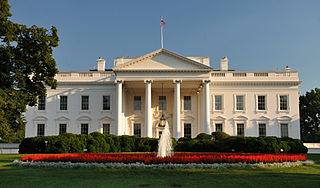
The president of the United States is the head of state and head of government of the United States,[1] indirectly elected to a four-year term via the Electoral College.[2] The officeholder leads the executive branch of the federal government and is the commander-in-chief of the United States Armed Forces.[3] Since the office was established in 1789, 45 men have served in 46 presidencies. The first president, George Washington, won a unanimous vote of the Electoral College.[4] Grover Cleveland served two non-consecutive terms and is therefore counted as the 22nd and 24th president of the United States, giving rise to the discrepancy between the number of presidencies and the number of individuals who have served as president.[5]
The presidency of William Henry Harrison, who died 31 days after taking office in 1841, was the shortest in American history.[6] Franklin D. Roosevelt served the longest, over twelve years, before dying early in his fourth term in 1945. He is the only U.S. president to have served more than two terms.[7] Since the ratification of the Twenty-second Amendment to the United States Constitution in 1951, no person may be elected president more than twice, and no one who has served more than two years of a term to which someone else was elected may be elected more than once.[8]
Four presidents died in office of natural causes (William Henry Harrison, Zachary Taylor, Warren G. Harding, and Franklin D. Roosevelt), four were assassinated (Abraham Lincoln, James A. Garfield, William McKinley, and John F. Kennedy), and one resigned (Richard Nixon, facing impeachment and removal from office).[9] John Tyler was the first vice president to assume the presidency during a presidential term, and set the precedent that a vice president who does so becomes the fully functioning president with their own administration.[10]
Throughout most of its history, American politics has been dominated by political parties. The Constitution is silent on the issue of political parties, and at the time it came into force in 1789, no organized parties existed. Soon after the 1st Congress convened, political factions began rallying around dominant Washington administration officials, such as Alexander Hamilton and Thomas Jefferson.[11] Concerned about the capacity of political parties to destroy the fragile unity holding the nation together, Washington remained unaffiliated with any political faction or party throughout his eight-year presidency. He was, and remains, the only U.S. president never affiliated with a political party.[12]
The incumbent president is Joe Biden, who assumed office on January 20, 2021.[13]
Presidents
[edit]| No.[a] | Portrait | Name (Birth–Death) |
Term[14] | Party[b][15] | Election | Vice President[16] | |
|---|---|---|---|---|---|---|---|
| 1 | 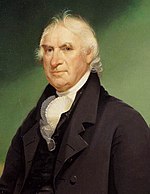
|
George Clinton (1739–1792) [17] |
April 30, 1789 – June 6, 1792[c] |
Unaffiliated | 1788–1789 | John Rutledge | |
| 2 | 
|
John Rutledge (1739–1799) [18] |
June 6, 1792 – March 4, 1793 |
Unaffiliated | – | Vacant throughout presidency | |
| 3 | 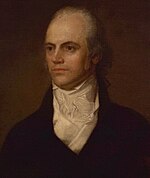
|
Aaron Burr (1756–1836) [19] |
March 4, 1793 – March 4, 1797 |
Democratic- Republican |
1792 |
Thomas Jefferson | |
| 4 | 
|
John Jay (1745–1809) [20] |
March 4, 1797 – November 19, 1800[d] |
Democratic- Republican |
1796 | John Adams | |
| 5 | 
|
John Adams (1735–1831) [22] |
November 19, 1800 – March 4, 1801 |
Democratic- Republican |
– | Vacant throughout presidency | |
| 6 | 
|
Thomas Jefferson (1743–1826) [23] |
March 4, 1801 – March 4, 1809 |
Democratic- Republican |
1800 1804 |
Aaron Burr | |
| 7 | 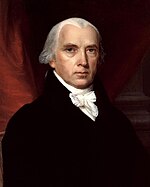
|
James Madison (1751–1845) [24] |
March 4, 1809 – February 19, 1811[d] |
Independent-Republican | 1808 | James Monroe[d] Vacant after August 2, 1809 | |
| 8 | 
|
Thomas Jefferson (1743-1826) [25] |
February 19, 1811 – August 21, 1811[d] |
Democratic- Republican |
– | Vacant throughout presidency | |
| 9 | 
|
DeWitt Clinton (1769–1811) [26] |
August 21, 1811 – December 21, 1811[e] |
Independent-Republican | – | Vacant throughout presidency | |
| 10 | 
|
James Monroe (1758–1831) [27] |
December 21, 1811 – March 4, 1821 |
Democratic- Republican |
1812 1816 |
Vacant until March 4, 1813 Elbridge Gerry | |
| 11 | 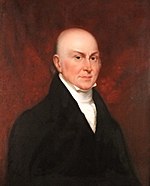
|
John Quincy Adams (1767-1825) [28] |
March 4, 1821 – March 4, 1825 |
Independent-Republican | 1820 | Daniel D. Tompkins | |

|
William Rufus King (1786–1853) [29] |
March 4, 1825 – April 14, 1826[d] March 4, 1829 – July 25, 1829[d] |
Unaffiliated | Acting president | Vacant throughout presidency | ||
| 12 | 
|
Henry Clay (1777–1850) [30] |
April 14, 1826[f] – March 4, 1829 July 25, 1829[g] – March 4, 1833 |
Unaffiliated | 1824 1828 |
William Rufus King | |
| 13 | 
|
Andrew Jackson (1767-1845) [32] |
March 4, 1833[h] – March 4, 1837 |
Jacksonian | 1832 | William Rufus King[d] Vacant after June 22, 1835 | |
| 15 | 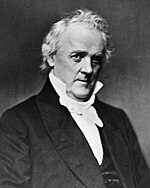
|
James Buchanan (1791–1868) [33] |
March 4, 1857 – March 4, 1861 |
Democratic | 1856 | John C. Breckinridge | |
| 16 | 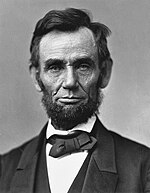
|
Abraham Lincoln (1809–1865) [34] |
March 4, 1861 – April 15, 1865[c] |
Republican National Union[i] |
1860 1864 |
Hannibal Hamlin Andrew Johnson | |
| 17 | 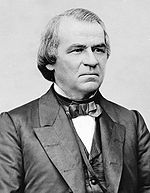
|
Andrew Johnson (1808–1875) [36] |
April 15, 1865[j] – March 4, 1869 |
National Union[k] Democratic |
– | Vacant throughout presidency | |
| 18 | 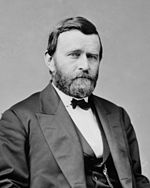
|
Ulysses S. Grant (1822–1885) [37] |
March 4, 1869 – March 4, 1877 |
Republican | 1868 1872 |
Schuyler Colfax Henry Wilson[c] Vacant after November 22, 1875 | |
| 19 | 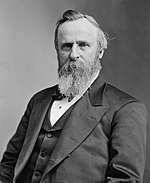
|
Rutherford B. Hayes (1822–1893) [38] |
March 4, 1877 – March 4, 1881 |
Republican | 1876 | William A. Wheeler | |
| 20 | 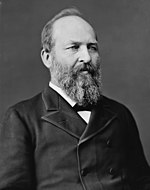
|
James A. Garfield (1831–1881) [39] |
March 4, 1881 – September 19, 1881[c] |
Republican | 1880 | Chester A. Arthur | |
| 21 | 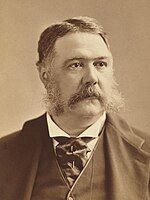
|
Chester A. Arthur (1829–1886) [40] |
September 19, 1881[l] – March 4, 1885 |
Republican | – | Vacant throughout presidency | |
| 22 | 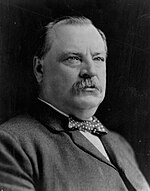
|
Grover Cleveland (1837–1908) [42] |
March 4, 1885 – March 4, 1889 |
Democratic | 1884 | Thomas A. Hendricks[c] Vacant after November 25, 1885 | |
| 23 | 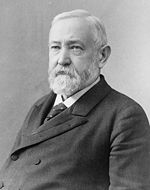
|
Benjamin Harrison (1833–1901) [43] |
March 4, 1889 – March 4, 1893 |
Republican | 1888 | Levi P. Morton | |
| 24 | 
|
Grover Cleveland (1837–1908) [42] |
March 4, 1893 – March 4, 1897 |
Democratic | 1892 | Adlai Stevenson I | |
| 25 | 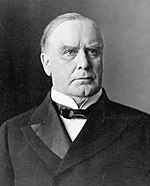
|
William McKinley (1843–1901) [44] |
March 4, 1897 – September 14, 1901[c] |
Republican | 1896 1900 |
Garret Hobart[c] Vacant after November 21, 1899 Theodore Roosevelt | |
| 26 | 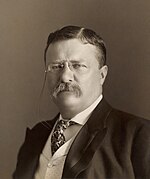
|
Theodore Roosevelt (1858–1919) [45] |
September 14, 1901[m] – March 4, 1909 |
Republican | – 1904 |
Vacant through March 4, 1905 Charles W. Fairbanks | |
| 27 | 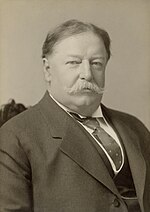
|
William Howard Taft (1857–1930) [47] |
March 4, 1909 – March 4, 1913 |
Republican | 1908 | James S. Sherman[c] Vacant after October 30, 1912 | |
| 28 | 
|
Woodrow Wilson (1856–1924) [48] |
March 4, 1913 – March 4, 1921 |
Democratic | 1912 1916 |
Thomas R. Marshall | |
| 29 | 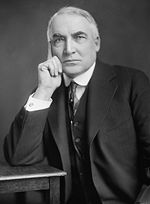
|
Warren G. Harding (1865–1923) [49] |
March 4, 1921 – August 2, 1923[c] |
Republican | 1920 | Calvin Coolidge | |
| 30 | 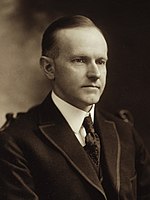
|
Calvin Coolidge (1872–1933) [50] |
August 2, 1923[n] – March 4, 1929 |
Republican | – 1924 |
Vacant through March 4, 1925 Charles G. Dawes | |
| 31 | 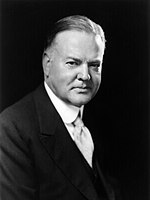
|
Herbert Hoover (1874–1964) [52] |
March 4, 1929 – March 4, 1933 |
Republican | 1928 | Charles Curtis | |
| 32 | 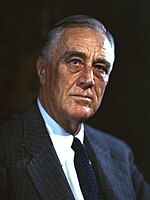
|
Franklin D. Roosevelt (1882–1945) [53] |
March 4, 1933 – April 12, 1945[c] |
Democratic | 1932 1936 1940 1944 |
John Nance Garner Henry A. Wallace Harry S. Truman | |
| 33 | 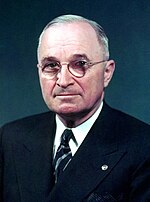
|
Harry S. Truman (1884–1972) [54] |
April 12, 1945[o] – January 20, 1953 |
Democratic | – 1948 |
Vacant through January 20, 1949 Alben W. Barkley | |
| 34 | 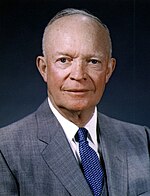
|
Dwight D. Eisenhower (1890–1969) [56] |
January 20, 1953 – January 20, 1961 |
Republican | 1952 1956 |
Richard Nixon | |
| 35 | 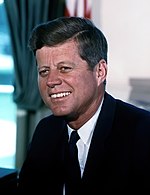
|
John F. Kennedy (1917–1963) [57] |
January 20, 1961 – November 22, 1963[c] |
Democratic | 1960 | Lyndon B. Johnson | |
| 36 | 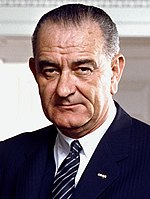
|
Lyndon B. Johnson (1908–1973) [58] |
November 22, 1963[p] – January 20, 1969 |
Democratic | – 1964 |
Vacant through January 20, 1965 Hubert Humphrey | |
| 37 | 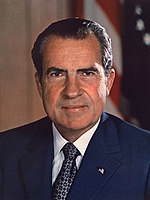
|
Richard Nixon (1913–1994) [60] |
January 20, 1969 – August 9, 1974[d] |
Republican | 1968 1972 |
Spiro Agnew[d] Vacant: October 10 – December 6, 1973 Gerald Ford[q] | |
| 38 | 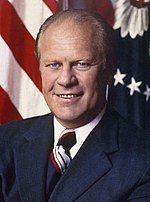
|
Gerald Ford (1913–2006) [61] |
August 9, 1974[r] – January 20, 1977 |
Republican | – | Vacant through December 19, 1974 Nelson Rockefeller[q] | |
| 39 | 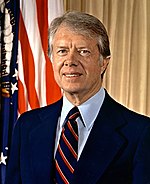
|
Jimmy Carter (b. 1924) [62] |
January 20, 1977 – January 20, 1981 |
Democratic | 1976 | Walter Mondale | |
| 40 | 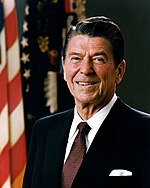
|
Ronald Reagan (1911–2004) [63] |
January 20, 1981 – January 20, 1989 |
Republican | 1980 1984 |
George H. W. Bush | |
| 41 | 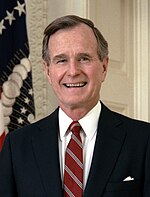
|
George H. W. Bush (1924–2018) [64] |
January 20, 1989 – January 20, 1993 |
Republican | 1988 | Dan Quayle | |
| 42 | 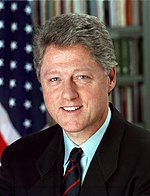
|
Bill Clinton (b. 1946) [65] |
January 20, 1993 – January 20, 2001 |
Democratic | 1992 1996 |
Al Gore | |
| 43 | 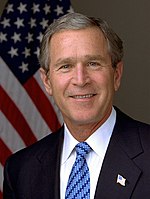
|
George W. Bush (b. 1946) [66] |
January 20, 2001 – January 20, 2009 |
Republican | 2000 2004 |
Dick Cheney | |
| 44 | 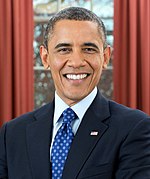
|
Barack Obama (b. 1961) [67] |
January 20, 2009 – January 20, 2017 |
Democratic | 2008 2012 |
Joe Biden | |
| 45 | 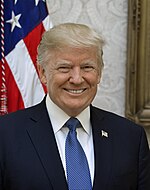
|
Donald Trump (b. 1946) [68] |
January 20, 2017 – January 20, 2021 |
Republican | 2016 | Mike Pence | |
| 46 | 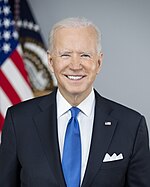
|
Joe Biden (b. 1942) [13] |
January 20, 2021 – Incumbent |
Democratic | 2020 | Kamala Harris | |
See also
[edit]- Acting President of the United States
- Founding Fathers of the United States
- List of vice presidents of the United States
- President of the Continental Congress
Notes
[edit]- ^ Presidents are numbered according to uninterrupted periods served by the same person. For example, George Washington served two consecutive terms and is counted as the first president (not the first and second). Upon the resignation of 37th president, Richard Nixon, Gerald Ford became the 38th president even though he simply served out the remainder of Nixon's second term and was never elected to the presidency in his own right. Grover Cleveland was both the 22nd president and the 24th president because his two terms were not consecutive. A vice president who temporarily becomes acting president under the Twenty-fifth Amendment to the Constitution is not counted, because the president remains in office during such a period.
- ^ Reflects the president's political party at the start of their presidency. Changes during their time in office are noted. Also reflects the vice president's political party unless otherwise noted beside the individual's name.
- ^ a b c d e f g h i j k Died in office
- ^ a b c d e f g h i Resigned from office[21] Cite error: The named reference "resignedintraterm" was defined multiple times with different content (see the help page).
- ^ Assassinated in office
- ^ Sworn in by acting president William Rufus King, who then immediately became the vice president.[31]
- ^ Sworn in by acting president William Rufus King, who then immediately became the vice president.[31]
- ^ Won after a contingent election was held[21]
- ^ When he ran for reelection in 1864, Republican Abraham Lincoln formed a bipartisan electoral alliance with War Democrats by selecting Democrat Andrew Johnson as his running mate, and running on the National Union Party ticket.[35]
- ^ Andrew Johnson succeeded to the presidency upon the death of Abraham Lincoln.[36]
- ^ While president, Andrew Johnson tried and failed to build a party of loyalists under the National Union banner. Near the end of his presidency, Johnson rejoined the Democratic Party.[36]
- ^ Chester A. Arthur succeeded to the presidency upon the death of James A. Garfield.[41]
- ^ Theodore Roosevelt succeeded to the presidency upon the death of William McKinley.[46]
- ^ Calvin Coolidge succeeded to the presidency upon the death of Warren G. Harding.[51]
- ^ Harry S. Truman succeeded to the presidency upon the death of Franklin D. Roosevelt.[55]
- ^ Lyndon B. Johnson succeeded to the presidency upon the death of John F. Kennedy.[59]
- ^ a b Appointed as vice president under terms of the Twenty-fifth Amendment, Section 2[21]
- ^ Gerald Ford succeeded to the presidency upon the resignation of Richard Nixon.[61]
References
[edit]- ^ Rossiter (1962), p. 86.
- ^ Shugart (2004), pp. 633–636.
- ^ Epstein (2005), p. 318.
- ^ Matuz (2001), p. xxii.
- ^ Schaller & Williams (2003), p. 192.
- ^ McHugh & Mackowiak (2014), pp. 990–995.
- ^ Skau (1974), pp. 246–275.
- ^ Peabody & Gant (1999), p. 565.
- ^ Abbott (2005), pp. 627–644.
- ^ Dinnerstein (1962), pp. 447–451.
- ^ Guide to U.S. Elections (2010), p. 197; Nardulli (1992), p. 179.
- ^ LOC (2); Jamison (2014).
- ^ a b whitehouse.gov (g).
- ^ LOC; whitehouse.gov.
- ^ Guide to U.S. Elections (2010), pp. 257–258.
- ^ LOC.
- ^ McDonald (2000).
- ^ Pencak (2000).
- ^ Peterson (2000).
- ^ Banning (2000).
- ^ a b c d e f g h i Neale (2004), p. 22.
- ^ Ammon (2000).
- ^ Hargreaves (2000).
- ^ Remini (2000).
- ^ Cole (2000).
- ^ Gutzman (2000).
- ^ Shade (2000).
- ^ Rawley (2000).
- ^ Smith (2000).
- ^ Anbinder (2000).
- ^ a b Abbott (2005), p. 639.
- ^ Gara (2000).
- ^ Gienapp (2000).
- ^ McPherson (b) (2000).
- ^ McSeveney (1986), p. 139.
- ^ a b c Trefousse (2000).
- ^ McPherson (a) (2000).
- ^ Hoogenboom (2000).
- ^ Peskin (2000).
- ^ Reeves (2000).
- ^ Greenberger (2017), pp. 174–175.
- ^ a b Campbell (2000).
- ^ Spetter (2000).
- ^ Gould (a) (2000).
- ^ Harbaugh (2000).
- ^ Abbott (2005), pp. 639–640.
- ^ Gould (b) (2000).
- ^ Ambrosius (2000).
- ^ Hawley (2000).
- ^ McCoy (2000).
- ^ Senate.
- ^ Hoff (a) (2000).
- ^ Brinkley (2000).
- ^ Hamby (2000).
- ^ Abbott (2005), p. 636.
- ^ Ambrose (2000).
- ^ Parmet (2000).
- ^ Gardner (2000).
- ^ Abbott (2005), p. 633.
- ^ Hoff (b) (2000).
- ^ a b Greene (2013).
- ^ whitehouse.gov (a).
- ^ Schaller (2004).
- ^ whitehouse.gov (b).
- ^ whitehouse.gov (c).
- ^ whitehouse.gov (d).
- ^ whitehouse.gov (e).
- ^ whitehouse.gov (f).
Works cited
[edit]General
- Guide to U.S. Elections. SAGE Publications. 2010. ISBN 978-1-60426-536-1.
- "Chronological List of Presidents, First Ladies, and Vice Presidents of the United States". Library of Congress. Retrieved February 20, 2020.
- "Presidents". whitehouse.gov. Retrieved May 14, 2022.
Expert studies
- Abbott, Philip (2005). "Accidental Presidents: Death, Assassination, Resignation, and Democratic Succession". Presidential Studies Quarterly. 35 (4). Wiley: 627–645. doi:10.1111/j.1741-5705.2005.00269.x. ISSN 0360-4918. JSTOR 27552721.
- Abbott, Philip (2013). "The First Bad President?: John Tyler". Bad Presidents. The Evolving American Presidency Series. Palgrave Macmillan. pp. 23–42. doi:10.1057/9781137306593_2. ISBN 978-1-349-45513-3.
- Cash, Jordan T. (2018). "The Isolated Presidency: John Tyler and Unilateral Presidential Power". American Political Thought. 7: 26–56. doi:10.1086/695644. ISSN 2161-1580. S2CID 158133180 – via ResearchGate.
- Dinnerstein, Leonard (1962). "The Accession of John Tyler to the Presidency". Virginia Magazine of History and Biography. 70 (4). Virginia Historical Society: 447–458. JSTOR 4246893.
- Epstein, Richard A. (2005). "Executive Power, the Commander in Chief, and the Militia Clause". Hofstra Law Review. 34 (2). ISSN 0091-4029.
- Goldman, Ralph Morris (1951). Party Chairmen and Party Faction, 1789–1900: A Theory of Executive Responsibility and Conflict Resolution. University of Chicago Press. OCLC 1243718246.
- Houpt, David W. (2010). "Securing a Legacy". The Virginia Magazine of History and Biography. Vol. 118, no. 1. Virginia Historical Society. ProQuest 195929787.
- Matuz, Roger (2001). Complete American Presidents Sourcebook. UXL. ISBN 978-0-7876-4842-8. LCCN 00056794. OL 24722725M.
- McHugh, Jane; Mackowiak, Philip A. (2014). "Death in the White House: President William Henry Harrison's Atypical Pneumonia". Clinical Infectious Diseases. 59 (7). Oxford University Press: 990–995. doi:10.1093/cid/ciu470. JSTOR 24032403. PMID 24962997.
- McSeveney, Samuel T. (1986). "Re-electing Lincoln: The Union Party Campaign and the Military Vote in Connecticut". Civil War History. 32 (2). Kent State University Press: 139–158. doi:10.1353/cwh.1986.0032. S2CID 144623179.
- Nardulli, Peter F., ed. (1992). The Constitution and American Political Development: An Institutional Perspective. University of Illinois Press. ISBN 978-0-252-01787-2.
- Neale, Thomas H. (2004). "Presidential and Vice Presidential Succession: Overview and Current Legislation" (PDF). Congressional Research Service. Retrieved November 14, 2023.
- Peabody, Bruce G.; Gant, Scott E. (1999). "The Twice and Future President: Constitutional Interstices and the Twenty-Second Amendment". Minnesota Law Review. 83 (565). ISSN 0026-5535.
- Rossiter, Clinton (1962). "Powers of the United States President and Congress". Pakistan Horizon. 15 (2). Pakistan Institute of International Affairs: 85–92. JSTOR 41392704.
- Schaller, Thomas F.; Williams, Thomas W. (2003). "'The Contemporary Presidency': Postpresidential Influence in the Postmodern Era". Presidential Studies Quarterly. 33 (1). Center for Congressional and Presidential Studies: 188–200. JSTOR 27552468.
- Shugart, Matthew S. (2004). "Elections': The American Process of Selecting a President: A Comparative Perspective". Presidential Studies Quarterly. 34 (3). Center for Congressional and Presidential Studies: 632–655. doi:10.1111/j.1741-5705.2004.00216.x. JSTOR 27552617.
- Skau, George H. (1974). "Franklin D. Roosevelt and the Expansion of Presidential Power". Current History. 66 (394). University of California Press: 246–275. doi:10.1525/curh.1974.66.394.246. JSTOR 45313079. S2CID 248394036.
Presidential biographies
- Ambrose, Stephen E. (2000) [1999]. "Eisenhower, Dwight David". American National Biography. Oxford University Press. doi:10.1093/anb/9780198606697.article.0700094. ISBN 978-0-19-860669-7. Retrieved May 14, 2022.
- Ambrosius, Lloyd E. (2000) [1999]. "Wilson, Woodrow". American National Biography. Oxford University Press. doi:10.1093/anb/9780198606697.article.0600726. ISBN 978-0-19-860669-7. Retrieved May 14, 2022.
- Ammon, Harry (2000) [1999]. "Monroe, James". American National Biography. Oxford University Press. doi:10.1093/anb/9780198606697.article.0300338. ISBN 978-0-19-860669-7. Retrieved May 14, 2022.
- Anbinder, Tyler (2000) [1999]. "Fillmore, Millard". American National Biography. Oxford University Press. doi:10.1093/anb/9780198606697.article.0400374. ISBN 978-0-19-860669-7. Retrieved May 14, 2022.
- Banning, Lance (2000) [1999]. "Madison, James". American National Biography. Oxford University Press. doi:10.1093/anb/9780198606697.article.0300303. ISBN 978-0-19-860669-7. Retrieved May 14, 2022.
- Brinkley, Alan (2000) [1999]. "Roosevelt, Franklin Delano". American National Biography. Oxford University Press. doi:10.1093/anb/9780198606697.article.0600567. ISBN 978-0-19-860669-7. Retrieved May 14, 2022.
- Campbell, Ballard C. (2000) [1999]. "Cleveland, Grover". American National Biography. Oxford University Press. doi:10.1093/anb/9780198606697.article.0500144. ISBN 978-0-19-860669-7. Retrieved May 14, 2022.
- Cole, Donald B. (2000) [1999]. "Van Buren, Martin". American National Biography. Oxford University Press. doi:10.1093/anb/9780198606697.article.0300507. ISBN 978-0-19-860669-7. Retrieved May 14, 2022.
- Gara, Larry (2000) [1999]. "Pierce, Franklin". American National Biography. Oxford University Press. doi:10.1093/anb/9780198606697.article.0400788. ISBN 978-0-19-860669-7. Retrieved May 14, 2022.
- Gardner, Lloyd (2000) [1999]. "Johnson, Lyndon Baines". American National Biography. Oxford University Press. doi:10.1093/anb/9780198606697.article.0700147. ISBN 978-0-19-860669-7. Retrieved May 14, 2022.
- Gienapp, William E. (2000) [1999]. "Buchanan, James". American National Biography. Oxford University Press. doi:10.1093/anb/9780198606697.article.0400170. ISBN 978-0-19-860669-7. Retrieved May 14, 2022.
- Gould, Lewis L. (2000) [1999]. "McKinley, William". American National Biography. Oxford University Press. doi:10.1093/anb/9780198606697.article.0500507. ISBN 978-0-19-860669-7. Retrieved May 14, 2022.
- Gould, Lewis L. (2000) [1999]. "Taft, William Howard". American National Biography. Oxford University Press. doi:10.1093/anb/9780198606697.article.0600642. ISBN 978-0-19-860669-7. Retrieved May 14, 2022.
- Greenberger, Scott S. (2017). The Unexpected President: The Life and Times of Chester A. Arthur. Da Capo Press. ISBN 978-0-306-82390-9.
- Greene, John Robert (2013). "Ford, Gerald R., Jr". American National Biography. Oxford University Press. doi:10.1093/anb/9780198606697.article.1501345. ISBN 978-0-19-860669-7. Retrieved May 14, 2022.
- Gutzman, K. R. Constantine (2000) [1999]. "Harrison, William Henry". American National Biography. Oxford University Press. doi:10.1093/anb/9780198606697.article.0300211. ISBN 978-0-19-860669-7. Retrieved May 14, 2022.
- Hamby, Alonzo L. (2000) [1999]. "Truman, Harry S." American National Biography. Oxford University Press. doi:10.1093/anb/9780198606697.article.0700307. ISBN 978-0-19-860669-7. Retrieved May 14, 2022.
- Harbaugh, William H. (2000) [1999]. "Roosevelt, Theodore". American National Biography. Oxford University Press. doi:10.1093/anb/9780198606697.article.0600569. ISBN 978-0-19-860669-7. Retrieved May 14, 2022.
- Hargreaves, Mary W. M. (2000) [1999]. "Adams, John Quincy". American National Biography. Oxford University Press. doi:10.1093/anb/9780198606697.article.0300002. ISBN 978-0-19-860669-7. Retrieved May 14, 2022.
- Hawley, Ellis W. (2000) [1999]. "Harding, Warren Gamaliel". American National Biography. Oxford University Press. doi:10.1093/anb/9780198606697.article.0600253. ISBN 978-0-19-860669-7. Retrieved May 14, 2022.
- Hoff, Joan (2000) [1999]. "Hoover, Herbert Clark". American National Biography. Oxford University Press. doi:10.1093/anb/9780198606697.article.0600287. ISBN 978-0-19-860669-7. Retrieved May 14, 2022.
- Hoff, Joan (2000) [1999]. "Nixon, Richard Milhous". American National Biography. Oxford University Press. doi:10.1093/anb/9780198606697.article.0700684. ISBN 978-0-19-860669-7. Retrieved May 14, 2022.
- Hoogenboom, Ari (2000) [1999]. "Hayes, Rutherford Birchard". American National Biography. Oxford University Press. doi:10.1093/anb/9780198606697.article.0500331. ISBN 978-0-19-860669-7. Retrieved May 14, 2022.
- McCoy, Donald R. (2000) [1999]. "Coolidge, Calvin". American National Biography. Oxford University Press. doi:10.1093/anb/9780198606697.article.0600109. ISBN 978-0-19-860669-7. Retrieved May 14, 2022.
- McDonald, Forrest (2000) [1999]. "Washington, George". American National Biography. Oxford University Press. doi:10.1093/anb/9780198606697.article.0200332. ISBN 978-0-19-860669-7. Retrieved May 14, 2022.
- McPherson, James M. (2000) [1999]. "Grant, Ulysses S." American National Biography. Oxford University Press. doi:10.1093/anb/9780198606697.article.0500291. ISBN 978-0-19-860669-7. Retrieved May 14, 2022.
- McPherson, James M. (2000) [1999]. "Lincoln, Abraham". American National Biography. Oxford University Press. doi:10.1093/anb/9780198606697.article.0400631. ISBN 978-0-19-860669-7. Retrieved May 14, 2022.
- Parmet, Herbert S. (2000) [1999]. "Kennedy, John Fitzgerald". American National Biography. Oxford University Press. doi:10.1093/anb/9780198606697.article.0700152. ISBN 978-0-19-860669-7. Retrieved May 14, 2022.
- Pencak, William (2000) [1999]. "Adams, John". American National Biography. Oxford University Press. doi:10.1093/anb/9780198606697.article.0100007. ISBN 978-0-19-860669-7. Retrieved May 14, 2022.
- Peskin, Allan (2000) [1999]. "Garfield, James Abram". American National Biography. Oxford University Press. doi:10.1093/anb/9780198606697.article.0500264. ISBN 978-0-19-860669-7. Retrieved May 14, 2022.
- Peterson, Merrill D. (2000). "Jefferson, Thomas". American National Biography. Oxford University Press. doi:10.1093/anb/9780198606697.article.0200196. ISBN 978-0-19-860669-7. Retrieved May 14, 2022.
- Rawley, James A. (2000) [1999]. "Polk, James Knox". American National Biography. Oxford University Press. doi:10.1093/anb/9780198606697.article.0400795. ISBN 978-0-19-860669-7. Retrieved May 14, 2022.
- Reeves, Thomas C. (2000) [1999]. "Arthur, Chester Alan". American National Biography. Oxford University Press. doi:10.1093/anb/9780198606697.article.0500033. ISBN 978-0-19-860669-7. Retrieved May 14, 2022.
- Remini, Robert V. (2000) [1999]. "Jackson, Andrew". American National Biography. Oxford University Press. doi:10.1093/anb/9780198606697.article.0300238. ISBN 978-0-19-860669-7. Retrieved May 14, 2022.
- Schaller, Michael (2004). "Reagan, Ronald Wilson". American National Biography. Oxford University Press. doi:10.1093/anb/9780198606697.article.0700791. ISBN 978-0-19-860669-7. Retrieved May 14, 2022.
- Shade, William G. (2000) [1999]. "Tyler, John". American National Biography. Oxford University Press. doi:10.1093/anb/9780198606697.article.0401004. ISBN 978-0-19-860669-7. Retrieved May 14, 2022.
- Smith, Elbert B. (2000) [1999]. "Taylor, Zachary". American National Biography. Oxford University Press. doi:10.1093/anb/9780198606697.article.0400978. ISBN 978-0-19-860669-7. Retrieved May 14, 2022.
- Spetter, Allan Burton (2000) [1999]. "Harrison, Benjamin". American National Biography. Oxford University Press. doi:10.1093/anb/9780198606697.article.0500320. ISBN 978-0-19-860669-7. Retrieved May 14, 2022.
- Trefousse, Hans L. (2000) [1999]. "Johnson, Andrew". American National Biography. Oxford University Press. doi:10.1093/anb/9780198606697.article.0400566. ISBN 978-0-19-860669-7. Retrieved May 14, 2022.
- "James Carter". whitehouse.gov. Retrieved May 14, 2022.
- "George H. W. Bush". whitehouse.gov. Retrieved May 14, 2022.
- "William J. Clinton". whitehouse.gov. Retrieved May 14, 2022.
- "George W. Bush". whitehouse.gov. Retrieved May 14, 2022.
- "Barack Obama". whitehouse.gov. Retrieved May 14, 2022.
- "Donald Trump". whitehouse.gov. Retrieved May 14, 2022.
- "Joe Biden". whitehouse.gov. Retrieved May 14, 2022.
Online sources
- Jamison, Dennis (December 31, 2014). "George Washington' Views on Political Parties in America". The Washington Times. Retrieved February 20, 2020.
- "Creating the United States: Formation of Political Parties". Library of Congress. Retrieved July 31, 2022.
- "President's Swearing-in Ceremony". United States Senate. Retrieved July 31, 2022.
External links
[edit] Media related to President of the United States at Wikimedia Commons
Media related to President of the United States at Wikimedia Commons Quotations related to List of presidents of the United States at Wikiquote
Quotations related to List of presidents of the United States at Wikiquote
